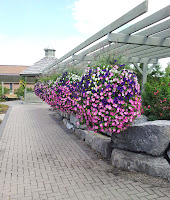Download the Spring Summer 2014 Calendar for a full course line up!
- Agriculture
- Animal Sciences
- Business
- Land & Environment
- Machinery & Trades
- Plants & Horticulture
- Special Interest
- Customized Training Solutions
HORT WEEK: YARD & GARDEN
The Mixed Edible Landscape - Beauty & Function
Surging interest in growing at least some portion of our food is challenging our concept of gardening in the urban setting. With smaller growing spaces available, people are seeking ways and means to integrate growing foodstuff s as well as plants grown primarily for beauty. Successful mixed edible gardens are productive, nutritious, and a delight to the eyes. This course will give you a comprehensive understanding of the basics of gardening and proper care of the plants that are grown both as foodstuff s and for their ornamental qualities. Designed for the ornamental gardener wanting to add edibles, or for mixed edible gardeners who are just getting started.
Heirloom Edible Gardening
Heritage varieties of edibles for home gardens have been attracting tremendous interest from gardeners in recent years. Whether you are interested in growing edibles that are not your usual fare or wanting to assist in the work to safeguard the genetic diversity of the plants that sustain us, this workshop will give you insight into the wonderful world of gardening with heirloom seeds.
This workshop will cover:
- What are heritage, heirloom, open pollinated and hybridized seeds
- The evolution of seed companies, plant breeding and modern day cultivars and hybrids
- The pros and cons of growing heritage and heirloom varieties in the home garden
- Implications for seed diversity and biodiversity in a world that is seeing increasing use of monocultures in industrial farming and GMO varieties
- The many varieties of heritage seeds that are successfully grown in Alberta gardens today
- Plus, what is being done to keep, preserve and promote heritage varieties in Alberta and Canada as a whole and how to get involved
Friend or Foe? Identifying Insects and Their Roles in the Yard & Garden
Have you ever wondered what those myriad creatures are in your yard and garden? Are they all there to feed on your plants or can they be doing something else? We will explore the Olds College Botanic Garden and Managed Wetlands to discover who is in your garden and what they might be doing. Learn how to diagnose problem pests and to distinguish them from the many species of beneficial insects carrying out necessary duties such as pollination and plant recycling.
The Scented Garden
Fragrance has long been the element that makes an attractive garden a memorable garden! Join Lyndon on a fascinating journey through a wide variety of scented annuals, perennials, trees and shrubs. You'll learn why some plants are more fragrant than others, and explore both scented foliage and blooms. You'll also learn where and how to grow them in order to get the most enjoyment from them!
And more...
HORT WEEK: DESIGN
Ready, Set, Garden! Get an overview of an environmentally friendly approach to the design and maintenance of your garden using daylilies as your principle perennial choice. The concepts of water and soil conservation, reduced pesticide use, and recycling of organic matter combine perfectly with appropriate daylily selection. In addition to classroom presentation, you will enjoy a tour of the daylily beds in the Botanic Garden and hands-on fun, dividing some daylily clumps to take home. Dress for gardening, whatever the weather, bring your gloves and enjoy!
Acreage Landscape Design
Are you overwhelmed by the prospect of landscaping your country residence? Join Angela Sommers to learn how to design and manage your projects. You will learn how to break down your spaces into zones and low maintenance solutions. Topics to be covered are outdoor living spaces, recreational spaces, wind breaks, special views, personal orchards, gardens, hardy plant material, creating privacy and driveways and walks.
Sustainable Landscaping
Want the most out of your outdoor space while enjoying the time and money savings sustainable landscaping has to off er? Join Angela Sommers for this exciting and informative day of lectures and workshops. We will be discussing water harvesting, organic gardening practices, sustainable design, hardy prairie fruit, building soil, ethical landscaping products, permaculture principles and sustainable construction. This course is a must for anyone interested in a healthy, productive environment.
And more...
HORT WEEK: HOMESTEADING
Introduction to Urban Chicken Keeping
Introduction to Urban Chicken Keeping is designed as a general overview of what is involved in keeping chickens in a city setting. Deborah Van Delden will explore the reasons why you would want to keep chickens and what it means to be a responsible owner and neighbour. The session will include discussion and information on a wide range of topics: chicken coops, breeds, chicken behaviour, purchasing your hens, feeding and caring for your hens, coop cleaning, health and illnesses, and how your hens can benefit your garden. Participants will have the opportunity to meet and handle some urban hens, and learn to examine the hens for healthy weights, signs of infestation, signs of moulting, and possible ailments. The instructors will also demonstrate how to trim a beak, clip wing feathers, trim toe nails, protect against frostbite and many other topics.
Cheese Making Workshop
Did you know that with some skills, some cultures, and equipment that you probably already have in your kitchen, you can produce your own homemade cheddar, fresh mozzarella, feta, cream cheese (... the list goes on)? This 3-hour course will walk you through the basics of at-home cheese making and give you a chance to taste some of the delicious and in finitely customizable dairy products you can produce for yourself. It will cover basic methods, tips and tricks, resources for materials, how to keep things clean and safe, and suggestions for serving and tweaking to make your taste buds happy.
And more...




















